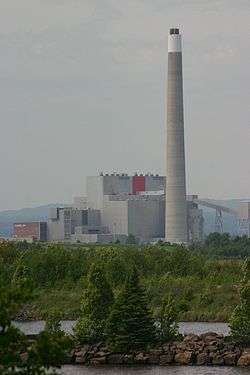Thunder Bay Generating Station
| Thunder Bay Generating Station | |
|---|---|
 The Thunder Bay Generating Station | |
| Country | Canada |
| Location | Thunder Bay, Ontario |
| Coordinates | 48°21′36″N 89°13′12″W / 48.36000°N 89.22000°WCoordinates: 48°21′36″N 89°13′12″W / 48.36000°N 89.22000°W |
| Status | Operational |
| Commission date |
1963 (coal) 2015 (biomass) |
| Owner(s) | Ontario Power Generation |
| Thermal power station | |
| Primary fuel | Advanced biomass |
| Type | Steam turbine |
The Thunder Bay Generating Station ("Thunder Bay GS") is a biomass-fired power station owned by Ontario Power Generation ("OPG"). It is located on Mission Island in Thunder Bay, on the shore of Lake Superior.[1]
Operating since 1963, Thunder Bay GS was the last coal fired station in Ontario. The plant was shut down in April 2014 as part of Ontario's phase out of coal-fired electricity generation.[2][3] It was converted to run on advanced biomass (wood pellets) and recommissioned on February 9, 2015.[4]
Historic operations
Thunder Bay GS began operation in 1963, with one 100 MW coal-fuelled generating unit. Two additional coal-fuelled units were added in the early 1980s, and in 1984 the original 100 MW unit was removed from service. This plant is connected to the power grid via 115 KV and 230 KV transmission lines. The station occupies 53 ha (131 acres) on Mission Island, at the mouth of the Kaministiquia River delta on Thunder Bay. The plant's chimney is 198 m (650 ft) tall.[5]
The two coal-fuelled boilers provided a peak output of 326 MW fuelled by low sulphur lignite coal from Western Canada and low sulphur sub-bituminous coal from the Powder River Basin in the United States.[5]
While operating as a coal plant, annual production was approximately 1.5 billion kilowatt-hours (KWh), enough energy to supply over 100,000 households for one year.
Conversion from coal
There were multiple announcements on the future of Thunder Bay GS over a 10-year period. The Ontario government initially proposed a conversion to natural gas in 2004 but subsequently cancelled that plan in 2006.[6]
Then, as part of the 2010 Long-Term Energy Plan, Ontario's Ministry of Energy announced that Thunder Bay GS would be converted from coal to natural gas by the end of 2014. This was part of the Ontario government's commitment to phase out all of its coal-burning power generation.[7]
On 1 November 2012, OPG announced that the Ontario Power Authority requested that the conversion to natural gas be suspended until the Ontario Power Authority could assess generating needs in northwestern Ontario.[8] The next announcement on the generating station's fate was made in November 2013 when the Ministry of Energy announced that Thunder Bay GS would be converted to advanced biomass.[2]
Ontario’s Minister of Energy Bob Chiarelli outlined the broad terms of the conversion in a directive [9] to the Ontario Power Authority dated 16 December 2013. Chiarelli noted that the station will have only one unit operating as a peaking plant and that OPG is only permitted to purchase 15,000 tonnes of fuel annually. It is estimated that the 15,000 tonnes of fuel will permit the single unit to operate at 2% of capacity.[10] It is expected that the generating station will have a five-year contract to produce electricity starting in January 2015.[11]
As of 2015, the plant burns steam treated wood pellets (biocoal) from Arbaflame in Norway.[12]
On July 27, 2018 OPG and IESO announced the closure of Thunder Bay Generating Station due to having a leak in the boiler causing the station to be shut down since May. Estimated repair costs would be about $5 million and the contract expiration in 2020 was not intended to be renewed. [13]
See also
References
- ↑ OPG - Thunder Bay Generating Station
- 1 2 http://www.cbc.ca/news/canada/thunder-bay/thunder-bay-generating-station-to-burn-biomass-1.2428035
- ↑ http://www.opg.com/news-and-media/news-releases/Documents/140415TBGSBurnsLastCoal.pdf
- ↑ http://www.tbnewswatch.com/News/367796/Generating_station_returns_to_grid_with_advanced_biomass
- 1 2 http://www.opg.com/power/thermal/brochures/thunderbaybrochure.pdf
- ↑ http://www.kenoradailyminerandnews.com/ArticleDisplay.aspx?e=2860212
- ↑ http://news.ontario.ca/mei/en/2010/11/thunder-bay-coal-plant-to-convert-to-cleaner-power.html
- ↑ http://www.opg.com/news/releases/TBay%20Conversion%20Suspension.pdf
- ↑ http://www.powerauthority.on.ca/sites/default/files/news/December-16-2013-Directive-Supply-Agreement-with-OPG.pdf
- ↑ http://www.northernontariobusiness.com/Industry-News/engineering/2014/01/Pellet-solution-will-save-on-power-plant-conversion-costs.aspx
- ↑ http://news.ontario.ca/mei/en/2013/11/cleaner-air-for-ontarians.html
- ↑ http://www.opg.com/news-and-media/news-releases/Documents/20151021_National%20Bioenergy%20Day.pdf
- ↑ https://www.tbnewswatch.com/local-news/generating-station-to-be-closed-998237